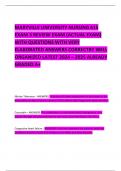MARYVILLE UNIVERSITY NURSING 615
EXAM 3 REVIEW EXAM (ACTUAL EXAM)
WITH QUESTIONS WITH VERY
ELABORATED ANSWERS CORRECTRY WELL
ORGANIZED LATEST 2024 – 2025 ALREADY
GRADED A+
Nitrate Tolerance - ANSWERS-Tolerance of these medications is described as the
attenuation or loss of one or several of the effects after long-term administration
Coumadin - ANSWERS-This medication is contraindicated in pregnancy, as it
passes through the placental barrier and may cause bleeding in the fetus.
Congestive heart failure - ANSWERS-First-line treatment for patients with this
condition should include ACE inhibitors (or ARBs) and beta blockers
,Colchine - ANSWERS-This medication treats gout, can cause severe diarrhea,
nausea, vomiting, abdominal pain
Febuxostat (Uloric) - ANSWERS-When prescribing this medication, patients should
be taught that gout may worsen before it improves. Can use NSAID or colchicine
with treatment for up to 6 months. Preventative therapy
Corticosteroids adverse effects - ANSWERS-These medications can cause the
following adverse effects if taken for six months or more: Osteoporosis and poor
diabetic control. Patients should report black, tarry stools or abdominal
pain...more
Corticosteroids - ANSWERS-These medications should be tapered to avoid
recurrent activity of the underlying disease and possible cortisol deficiency
resulting from the hypothalamic-pituitary-adrenal axis suppression during the
period of steroid therapy.
Low-dose colchine - ANSWERS-1.2 mg at first sign of flare, followed by 0.6 mg one
hour later for a total dose of 1.8 mg. Used for gout
High-dose colchine - ANSWERS-1.2 mg followed by 0.6 mg every 4-6 hours
totaling 4.8 mg.- not recommended/ used for gout
Gout - ANSWERS-Uric acid, liver and kidney lab, BUN, creatinine, and creatinine
clearance should be monitored in the treatment of this disease, CBC if colchicine
is used
,Black Box Warning on NSAIDS - ANSWERS-Increased risk of serious cardiovascular
thrombotic events, such as myocardial infarction and stroke. These medications
can also cause serious GI events such as bleeding, ulceration or perforation of
stomach or intestines, which can be fatal.
Pain management - ANSWERS-Non-opioid first choice- especially for inflammatory
pain (NSAID). May use Tylenol for non-inflammatory pain
Ibuprofen - ANSWERS-Non-selective COX-2 inhibitor, inhibits COX-2 which
decreases prostaglandin synthesis in mediating inflammation, pain, fever, and
swelling
Acetaminophen - ANSWERS-Liver failure / renal failure
Symptoms of hypoglycemia - ANSWERS-Decreased LOC, hunger, diaphoresis,
weakness, dizziness and tachycardia
Symptoms of hyperglycemia - ANSWERS-Polyuria, polydipsia and polyphagia
(weight loss)
Symptoms of DKA - ANSWERS-Kussmaul's respiration, ketone odor of the breath
(fruity breath), vomiting, dehydration, abdominal pain, and neurologic symptoms
such as lethargy; can progress to coma in later stages if left untreated.
, Metformin - ANSWERS-This medication decreases hepatic glucose output
inhibiting gluconeogenesis. It also increases insulin mediated glucose utilization in
peripheral tissues. This medication decreases intestinal absorption of glucose.
This medication may also be used in diabetics to decrease cholesterol and
triglyceride levels.
Metformin - ANSWERS-When patients are prescribed this medication, the primary
care provider should assess serum creatinine, renal function, and creatinine
clearance initially and annually.
Gliptins (DPP4 inhibitors) - ANSWERS-These medications increase the incretin
levels, which inhibit glucagon release; this subsequently increases insulin
secretion, decreases gastric emptying and decreases blood glucose levels.
GLP-1 agonists - ANSWERS-These medications bind directly to the GLP-1 receptor,
which then slows gastric emptying and increases insulin secretion by pancreatic
beta cells.
Exenatide (Byetta) - ANSWERS-This medication should be administered 60
minutes before breakfast and dinner.
PTU - ANSWERS-Adverse effects of this medication include fatal granuloctyopenia
(presents as fever and slow throat), vasculitis, temporary alopecia, rash, aplastic
anemia, and acute renal failure.




